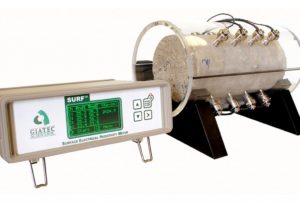How smart technology is changing the concrete industry for the better

By Sarah McGuire
John Oliver, the host of HBO’s Last Week Tonight has been vociferously exposing problems in America free of television censorship thanks to the paid television network on which the show is hosted. During the segment aired on March 8th he exposed poor state of America’s infrastructure by comparing it to that of a Lego set. He pointed out that although infrastructure may not be the most glamorous and ‘sexy’ topic, it is vitally important to the economy. Using his incisive wit, he was able to shine a
spotlight on an unpopular subject and make Americans realise they are dealing with a serious issue.
Although faulty dams and bridges pose life threatening consequences, simple infrastructural deficiencies such as potholes have also been responsible for fatalities. The 21st century has seen innovations and advancements across all industries, and the concrete industry has been no exception. However, the industry has been slow to respond to and take advantage of the opportunities presented.
Potentially the most groundbreaking advancement in the industry is 3D printing and its capacity to revolutionise the construction of infrastructure. In November 2014, Loughborough University, London, signed an agreement with Skanksa UK and architecture firm Foster + Partners to develop and commercialise 3D-printed cement and concrete structures. The objective is to have architects create their projects and have them developed at the touch of a button. The new technology enables architects to develop and print more complex designs that would otherwise be extremely difficult to create with conventional concrete practices. Other universities such as the University of California, Berkeley have also made remarkable innovations in 3D concrete printing. A structure built using 3D technology at UC Berkeley has been named ‘Bloom’ and will be disassembled soon to be sent to Thailand for display, and is set to do a tour of South East Asia six months later. The structure is nine feet tall containing 840 pieces, each one different from its 839 counterparts. While these new advances in 3D printing in the concrete industry are exciting, an important factor to keep in mind is ensuring these new structures are safe and sustainable.
Another major enhancement to the technology used by the concrete industry is currently defying conventional ways of testing for sustainability and durability. The most common form of concrete testing is the Rapid Chloride Permeability Test, also known as an RCP test, but new research breakthroughs show that testing the electrical resistivity in a concrete slab is not only more accurate and timely, but there are also many applications because of the vast number of parameters it can test for.
The first method to test the electrical resistivity is the Uniaxial method, done by placing a concrete slab between two electrodes with moist sponges at the points of contact for best results. AC current is applied to the sample and the potential between the electrodes is measured.
The other method is the four-point (also known as Wenner probe) method in which four electrodes are lined up, evenly spaced. The two inner electrodes measure the electrical potential V created when the exterior electrodes apply an AC current I to the concrete.
Both of the test methods are very effective but have yet to be properly recognised as being a reliable means of testing electrical resistivity. Giatec Scientific, a Canadian-based company specialises in test methods for electrical resistivity, but has also incorporated smart technology into their devices to adapt to consumer trends.

The advancements in the industry are influencing new practices and thus, new businesses, but they are also enabling old companies to capitalise on the technology and change their business models. Progress Builders, a San Jose, California based company has recently announced the release of a new application, available on iOS software devices. This not only allows users to filter through contractors, it also allows them to build profiles and create a project portfolio, evidently taking advantage of the social media age to improve their businesses.
Similar to some pizza chains that allow customers to customise their order online, this application has been able to condense all information required for a project and have a consumer tailor their needs at the touch of a screen.
This process will cut immense labour and opportunity costs, and this general idea is being seen in many business practices. Another concrete company, Dufferin Concrete, has launched a mobile application named U-Track to keep a location record of concrete pour deliveries. When dealing with perishable concrete mixes it is imperative to have an updated record to hand, and will provide a value-added component of their service to clients.
The construction industry has slowed down since the exponential increase from 1970-2000, but there is still much room for growth and innovation. The industry is changing rapidly and in order to stay current with the times, it is becoming ever-increasingly important to adjust to the advancements and exploit new technology.
Although there are learning curves involved, adaptation will also give industries, governments and research institutions a great competitive advantage. It is time to take advantage of the software applications and new technology available as one step towards solving the problems associated with the industry as a whole.
Source: Concrete Trends May Issue





